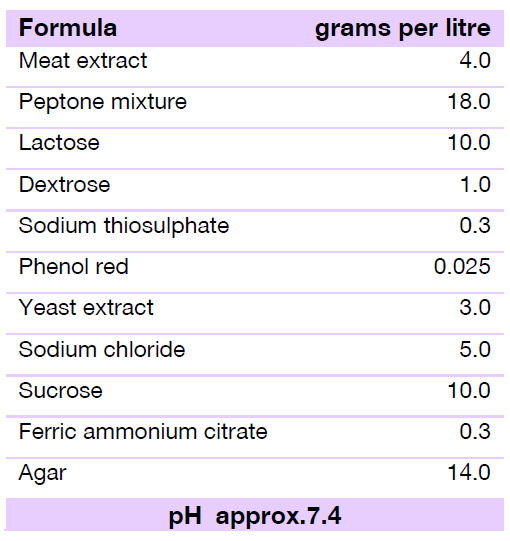Description
Triple Sugar Iron Agar (T.S.I.) | DM224D
For the differentiation of Enterobacteriaceae based on hydrogen sulphide production and fermentation of lactose, sucrose and dextrose.
MAST Triple Sugar Iron Agar (T.S.I.) is a composite medium for the differentiation of the Enterobacteriaceae. The medium can be regarded as being identical to MAST Kligler's Iron Agar (DM137) but with the addition of sucrose. The presence of this sugar permits the recognition and exclusion from further study of members of the proteus and 'paracolon' groups. In 1940 Sulkin and Willett1 described a triple sugar, ferrous sulphate medium for the identification of enteric bacteria. Later Hajna2 described a similar medium containing phenol red as indicator. The MAST formulation of T.S.I. is based on Hajna's recommendations.
Technical Formula

Directions
1. Suspend by swirling 65.6g of powder in 1 litre or the contents of the sachet in the stated volume of distilled or deionised water.
2. Bring to boil and dissolve completely.
3. Mix well and distribute.
4. Autoclave at 121ºC (15 p.s.i.) for 15 minutes.
5. Allow to set as slopes with butts about 1 inch long.
In Use
Single colonies from the selective plating media are inoculated onto T.S.I. Agar by smearing the slope and stabbing the butt. To aid differentiation of Proteus spp. and certain other organisms, a Urea Agar slope (DM228) should be inoculated in parallel. Incubate at 37ºC. It is important to use pure cultures and if there is any doubt, prior subculture onto MacConkey Agar (DM140) should be made.
Slopes of Urea Agar showing a positive (red) reaction after 3-5 hours incubation should be discarded. Where there is no urease production examine the T.S.I. slopes after 18 and 48 hours.
Results obtained with T.S.I., or Kligler's Iron Agar constitute presumptive evidence only and must be confirmed serologically after subculture of the organisms into Nutrient Broth (DM180).
Typical Reactions (Edwards and Ewing 1972)3

A = Acid symbols enclosed in parentheses
K = Alkaline indicate occasional reactions.






